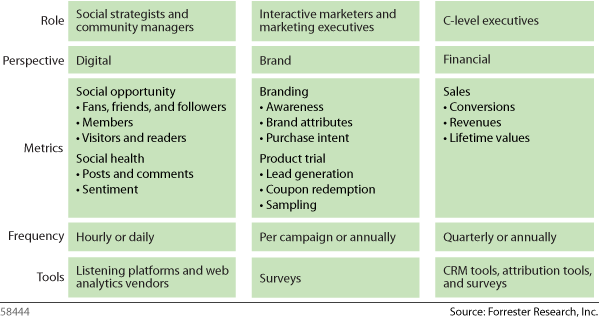Which Social Media Marketing Metrics Really Matter? (And To Whom?)
We’ve been pretty vocal over the past couple of years about how marketers should define success in social media and (perhaps more importantly) how they shouldn’t define success. To put it bluntly, if you’re focusing on fans and followers, then you’re almost certainly doing it wrong.
But saying that raises the question: If the number of fans or followers you have doesn’t tell us whether you’ve succeeded as a company, then what does it tell you? And if your CEO shouldn’t be worried about the number of wall posts you’ve generated, then who should be paying attention to this number?
Since last summer, I’ve been using a structured model to help my clients focus on delivering the right social media marketing data to various stakeholders inside their organization. Social media programs throw off so much data that the key to measuring and managing your programs well is focusing each stakeholder on just the pieces of data that are relevant to helping them do their jobs. If part of your job is measuring the success of your social media marketing programs, then you need to start segmenting the stakeholder groups you’re providing that data to and tailoring the type of metrics, the volume of metrics, and the frequency of reporting you provide them.
What does that mean in practice? Well, it's little surprise that your operational social media team — the community managers and social strategists who work with social media every day — need a huge volume and depth of data, focused primarily on digital metrics like fans, visitors, and comments. Without that reporting, they can’t do their jobs well. But as tempting as it is to show this same data to the rest of your marketing team, they simply don’t need that type (or depth, or frequency) of reporting — they mostly need data focused on brand impact, leads, and product trial. Likewise, your executives only need a moderate volume and a low frequency of data about your programs, and that data should be focused on bottom-line business results.
Last night I published a new report, Social Media Marketing Metrics That Matter, and it included the model I’ve been using:

Why did I put the stakeholder groups in the order I did? Partly because as you go from left to right, the rank of the stakeholder gets higher — and partly because as you go from left to right, the volume and frequency of reporting goes down.
But mostly it’s because each new group needs to build on the success of the group before it. It's true that the digital metrics that your community managers require can’t define success in social media marketing — but those metrics do tell you if those employees are doing their jobs well, and those smaller victories create the foundation your marketing team needs to succeed. Likewise, the brand and trial metrics that your marketing team should measure in social media aren’t the ultimate definition of business success in social media — but they can show that your marketers are using social media well, and without them doing so your business can’t get the value it needs from social media. Finally, the business-unit heads and C-level executives will find that the sales and other financial metrics they’re tracking are built on the back of those previous successes.
How do you report the impact of social media marketing programs inside your organization? Do you tailor your reporting to different types of employees? Leave your thoughts in the comments below.